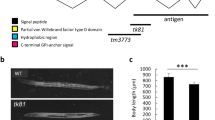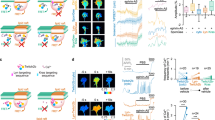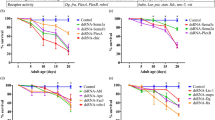Abstract
Axons navigating through the developing nervous system are instructed by external attractive and repulsive cues. Emerging evidence suggests the same cues control dendrite development, but it is not understood how they differentially instruct axons and dendrites. We studied a C. elegans motor neuron whose axon and dendrite adopt different trajectories and lengths. We found that the guidance cue UNC-6 (Netrin) is required for both axon and dendrite development. Its repulsive receptor UNC-5 repelled the axon from the ventral cell body, whereas the attractive receptor UNC-40 (DCC) was dendritically enriched and promotes antero-posterior dendritic growth. Although the endogenous ventrally secreted UNC-6 instructs axon guidance, dorsal or even membrane-tethered UNC-6 could support dendrite development. Unexpectedly, the serine-threonine kinase PAR-4 (LKB1) was selectively required for the activity of the UNC-40 pathway in dendrite outgrowth. These data suggest that axon and dendrite of one neuron interpret common environmental cues with different receptors and downstream signaling pathways.
This is a preview of subscription content, access via your institution
Access options
Subscribe to this journal
Receive 12 print issues and online access
$209.00 per year
only $17.42 per issue
Buy this article
- Purchase on Springer Link
- Instant access to full article PDF
Prices may be subject to local taxes which are calculated during checkout







Similar content being viewed by others
References
Polleux, F., Morrow, T. & Ghosh, A. Semaphorin 3A is a chemoattractant for cortical apical dendrites. Nature 404, 567–573 (2000).
Komiyama, T., Sweeney, L.B., Schuldiner, O., Garcia, K.C. & Luo, L. Graded expression of semaphorin-1a cell-autonomously directs dendritic targeting of olfactory projection neurons. Cell 128, 399–410 (2007).
Hedgecock, E.M., Culotti, J.G. & Hall, D.H. The unc-5, unc-6, and unc-40 genes guide circumferential migrations of pioneer axons and mesodermal cells on the epidermis in C. elegans. Neuron 4, 61–85 (1990).
Kidd, T., Bland, K.S. & Goodman, C.S. Slit is the midline repellent for the robo receptor in Drosophila. Cell 96, 785–794 (1999).
Suli, A., Mortimer, N., Shepherd, I. & Chien, C.B. Netrin/DCC signaling controls contralateral dendrites of octavolateralis efferent neurons. J. Neurosci. 26, 13328–13337 (2006).
Furrer, M.P., Kim, S., Wolf, B. & Chiba, A. Robo and Frazzled/DCC mediate dendritic guidance at the CNS midline. Nat. Neurosci. 6, 223–230 (2003).
Furrer, M.P., Vasenkova, I., Kamiyama, D., Rosado, Y. & Chiba, A. Slit and Robo control the development of dendrites in Drosophila CNS. Development 134, 3795–3804 (2007).
Finger, J.H. et al. The netrin 1 receptors Unc5h3 and Dcc are necessary at multiple choice points for the guidance of corticospinal tract axons. J. Neurosci. 22, 10346–10356 (2002).
Serafini, T. et al. The netrins define a family of axon outgrowth-promoting proteins homologous to C. elegans UNC-6. Cell 78, 409–424 (1994).
Serafini, T. et al. Netrin-1 is required for commissural axon guidance in the developing vertebrate nervous system. Cell 87, 1001–1014 (1996).
Gertler, F.B. et al. enabled, a dosage-sensitive suppressor of mutations in the Drosophila Abl tyrosine kinase, encodes an Abl substrate with SH3 domain-binding properties. Genes Dev. 9, 521–533 (1995).
Yu, T.W., Hao, J.C., Lim, W., Tessier-Lavigne, M. & Bargmann, C.I. Shared receptors in axon guidance: SAX-3/Robo signals via UNC-34/Enabled and a Netrin-independent UNC-40/DCC function. Nat. Neurosci. 5, 1147–1154 (2002).
Adler, C.E., Fetter, R.D. & Bargmann, C.I. UNC-6/Netrin induces neuronal asymmetry and defines the site of axon formation. Nat. Neurosci. 9, 511–518 (2006).
Gitai, Z., Yu, T.W., Lundquist, E.A., Tessier-Lavigne, M. & Bargmann, C.I. The netrin receptor UNC-40/DCC stimulates axon attraction and outgrowth through enabled and, in parallel, Rac and UNC-115/AbLIM. Neuron 37, 53–65 (2003).
Chang, C. et al. MIG-10/lamellipodin and AGE-1/PI3K promote axon guidance and outgrowth in response to slit and netrin. Curr. Biol. 16, 854–862 (2006).
Ming, G. et al. Phospholipase C-gamma and phosphoinositide 3-kinase mediate cytoplasmic signaling in nerve growth cone guidance. Neuron 23, 139–148 (1999).
Liu, G. et al. Netrin requires focal adhesion kinase and Src family kinases for axon outgrowth and attraction. Nat. Neurosci. 7, 1222–1232 (2004).
Zhu, X.J. et al. Myosin X regulates netrin receptors and functions in axonal path-finding. Nat. Cell Biol. 9, 184–192 (2007).
Li, X. et al. Netrin signal transduction and the guanine nucleotide exchange factor DOCK180 in attractive signaling. Nat. Neurosci. 11, 28–35 (2008).
Liu, G. et al. p130CAS is required for netrin signaling and commissural axon guidance. J. Neurosci. 27, 957–968 (2007).
White, J.G., Southgate, E., Thomson, J.N. & Brenner, S. The structure of the nervous system of the nematode Caenorhabditis elegans. Philos. Trans. R. Soc. Lond., B, Biol. Sci. 314, 1–340 (1986).
Sym, M., Robinson, N. & Kenyon, C. MIG-13 positions migrating cells along the anteroposterior body axis of C. elegans. Cell 98, 25–36 (1999).
Klassen, M.P. & Shen, K. Wnt signaling positions neuromuscular connectivity by inhibiting synapse formation in C. elegans. Cell 130, 704–716 (2007).
Wadsworth, W.G. Moving around in a worm: netrin UNC-6 and circumferential axon guidance in C. elegans. Trends Neurosci. 25, 423–429 (2002).
Wadsworth, W.G., Bhatt, H. & Hedgecock, E.M. Neuroglia and pioneer neurons express UNC-6 to provide global and local netrin cues for guiding migrations in C. elegans. Neuron 16, 35–46 (1996).
Hamelin, M., Zhou, Y., Su, M.W., Scott, I.M. & Culotti, J.G. Expression of the UNC-5 guidance receptor in the touch neurons of C. elegans steers their axons dorsally. Nature 364, 327–330 (1993).
Poon, V.Y., Klassen, M.P. & Shen, K. UNC-6/netrin and its receptor UNC-5 locally exclude presynaptic components from dendrites. Nature 455, 669–673 (2008).
Colón-Ramos, D.A., Margeta, M.A. & Shen, K. Glia promote local synaptogenesis through UNC-6 (netrin) signaling in C. elegans. Science 318, 103–106 (2007).
Zhou, P. et al. Polarized signaling endosomes coordinate BDNF-induced chemotaxis of cerebellar precursors. Neuron 55, 53–68 (2007).
Brankatschk, M. & Dickson, B.J. Netrins guide Drosophila commissural axons at short range. Nat. Neurosci. 9, 188–194 (2006).
Moore, S.W., Biais, N. & Sheetz, M.P. Traction on immobilized netrin-1 is sufficient to reorient axons. Science 325, 166 (2009).
Watts, J.L., Morton, D.G., Bestman, J. & Kemphues, K.J. The C. elegans par-4 gene encodes a putative serine-threonine kinase required for establishing embryonic asymmetry. Development 127, 1467–1475 (2000).
Barnes, A.P. et al. LKB1 and SAD kinases define a pathway required for the polarization of cortical neurons. Cell 129, 549–563 (2007).
Kemphues, K.J., Priess, J.R., Morton, D.G. & Cheng, N.S. Identification of genes required for cytoplasmic localization in early C. elegans embryos. Cell 52, 311–320 (1988).
Tenlen, J.R., Molk, J.N., London, N., Page, B.D. & Priess, J.R. MEX-5 asymmetry in one-cell C. elegans embryos requires PAR-4- and PAR-1-dependent phosphorylation. Development 135, 3665–3675 (2008).
Shelly, M., Cancedda, L., Heilshorn, S., Sumbre, G. & Poo, M.M. LKB1/STRAD promotes axon initiation during neuronal polarization. Cell 129, 565–577 (2007).
Kolodziej, P.A. et al. frazzled encodes a Drosophila member of the DCC immunoglobulin subfamily and is required for CNS and motor axon guidance. Cell 87, 197–204 (1996).
Chan, S.S. et al. UNC-40, a C. elegans homolog of DCC (Deleted in Colorectal Cancer), is required in motile cells responding to UNC-6 netrin cues. Cell 87, 187–195 (1996).
Lim, Y.S., Mallapur, S., Kao, G., Ren, X.C. & Wadsworth, W.G. Netrin UNC-6 and the regulation of branching and extension of motoneuron axons from the ventral nerve cord of Caenorhabditis elegans. J. Neurosci. 19, 7048–7056 (1999).
Hagedorn, E.J. et al. Integrin acts upstream of netrin signaling to regulate formation of the anchor cell's invasive membrane in C. elegans. Dev. Cell 17, 187–198 (2009).
Margeta, M.A., Wang, G.J. & Shen, K. Clathrin adaptor AP-1 complex excludes multiple postsynaptic receptors from axons in C. elegans. Proc. Natl. Acad. Sci. USA 106, 1632–1637 (2009).
Suzuki, A. & Ohno, S. The PAR-aPKC system: lessons in polarity. J. Cell Sci. 119, 979–987 (2006).
Morton, D.G., Roos, J.M. & Kemphues, K.J. par-4, a gene required for cytoplasmic localization and determination of specific cell types in Caenorhabditis elegans embryogenesis. Genetics 130, 771–790 (1992).
Martin, S.G. & St Johnston, D. A role for Drosophila LKB1 in anterior-posterior axis formation and epithelial polarity. Nature 421, 379–384 (2003).
Asada, N., Sanada, K. & Fukada, Y. LKB1 regulates neuronal migration and neuronal differentiation in the developing neocortex through centrosomal positioning. J. Neurosci. 27, 11769–11775 (2007).
Polleux, F., Giger, R.J., Ginty, D.D., Kolodkin, A.L. & Ghosh, A. Patterning of cortical efferent projections by semaphorin-neuropilin interactions. Science 282, 1904–1906 (1998).
Fire, A., Kondo, K. & Waterston, R. Vectors for low copy transformation of C. elegans. Nucleic Acids Res. 18, 4269–4270 (1990).
Mello, C. & Fire, A. DNA transformation. Methods Cell Biol. 48, 451–482 (1995).
Acknowledgements
We thank the International Caenorhabditis Genetic Center and the C. Kenyon (University of California, San Francisco), E. Lundquist (University of Kansas) and C. Bargmann (Rockefeller University) laboratories for strains and K. Kemphues laboratory (Cornell University) for par-4 cDNA, as well as C. Gao and Y. Fu for technical assistance. This work was supported by the Human Frontier Science Foundation, the W. M. Keck Foundation and the Howard Hughes Medical Institute (K.S.) and a Boehringer Ingelheim graduate fellowship (H.M.T.).
Author information
Authors and Affiliations
Contributions
H.M.T. performed all experiments. H.M.T. and K.S. designed and analyzed the experiments and wrote the manuscript.
Corresponding author
Ethics declarations
Competing interests
The authors declare no competing financial interests.
Supplementary information
Supplementary Text and Figures
Supplementary Figures 1–7 and Supplementary Table 1 (PDF 1285 kb)
Rights and permissions
About this article
Cite this article
Teichmann, H., Shen, K. UNC-6 and UNC-40 promote dendritic growth through PAR-4 in Caenorhabditis elegans neurons. Nat Neurosci 14, 165–172 (2011). https://doi.org/10.1038/nn.2717
Received:
Accepted:
Published:
Issue Date:
DOI: https://doi.org/10.1038/nn.2717
This article is cited by
-
The Netrin-1/DCC guidance system: dopamine pathway maturation and psychiatric disorders emerging in adolescence
Molecular Psychiatry (2020)
-
Intrinsic and extrinsic mechanisms of synapse formation and specificity in C. elegans
Cellular and Molecular Life Sciences (2019)
-
Netrin-1 directs dendritic growth and connectivity of vertebrate central neurons in vivo
Neural Development (2015)
-
Netrin (UNC-6) mediates dendritic self-avoidance
Nature Neuroscience (2012)
-
A conserved juxtacrine signal regulates synaptic partner recognition in Caenorhabditis elegans
Neural Development (2011)



